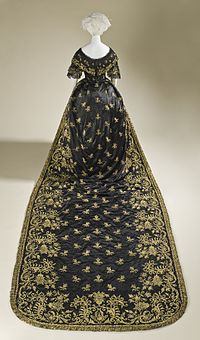
In clothing, a train describes the long back portion of a robe, coat, cloak, skirt, overskirt, or dress that trails behind the wearer.
It is a common part of ceremonial robes in academic dress, court dress or court uniform. It is also a common part of a woman's formal evening gowns or wedding dresses.
Trains in modern (20th and 21st century) bridal wear have their own terminology:
Brides of the Ndebele people of South Africa traditionally wear long beaded trains hung from the shoulder, known as nyoga (snake).[7]

Trains are a common feature of the Royal mantles of Kings and Princes, as well as the mantles of many chivalric orders.
Officers of older, traditional universities generally wear distinctive and more elaborate dress. The Chancellor and the Vice-Chancellor may wear a black damask lay type gown with a long train.[8][9][10] In France the train is now usually hooked to the inner side of the robe.
The Lord Chief Justice of England and Wales, when robed, dresses like a High Court Judge with the distinction of a train to his scarlet robe.[11]

Judges of the Court of Appeal wear the black silk damask gown, trained and heavily embellished with gold embroidery.
French court dress includes a train, now buttoned to the inside of the robe and suspended by fabric bands, a vestige of the former practice of lawyers carrying their trains.[12]
The Lord Chancellor, the Speaker of the House of Commons, and other high dignitaries also wear similar embroidered black robes with trains.[13]
The Lord Mayor of London also wears a robe with a train.[14]
A trained robe, the cappa magna (great cape) remains in use in the Catholic Church for certain ceremonial occasions. Cardinals, bishops, and certain other honorary prelates are entitled to wear the cappa magna, but within the territory of their jurisdiction.[15]
Eastern Orthodox bishops also traditionally use a cloak with a long train known as the Mandyas, which may have parallels with the development of the Catholic cappa magna.

For male peers, the Coronation robe is a cloak of crimson velvet extending to the feet, open in the front (with white silk satin ribbon ties) with train trailing behind.[16] The Parliament robe of a British peer is a full-length garment of scarlet wool with a collar of white miniver fur, cut long as a train, but this is usually kept hooked up inside the garment.[17]
Court dresses for women were commonly fifteen yards in length.[2] Court dresses for noble women sometimes had trains both behind and in front of the dress.[4]
Japanese Imperial court clothing, sokutai for men and jūnihitoe for women, both include a long train extending from the back of the robe. It remains in use with the Imperial Household of Japan for ceremonial occasions.[18]

Trains declined in popularity in the late nineteenth century when they were targeted by public health campaigns in Europe and the United States that argued they brought germs from the streets into the wearers' homes. The issue was the subject of a cartoon published in Puck in 1900 entitled "The Trailing Skirt: Death Loves a Shining Mark."[19]